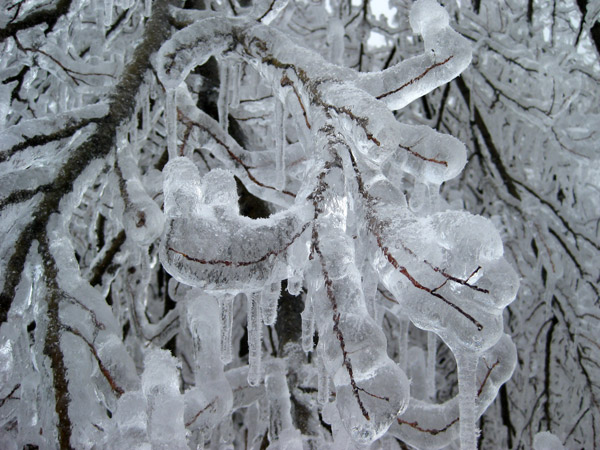Ice Storm
Contact
University of Arkansas System Division of Agriculture
Cooperative Extension Service
2301 S. University Ave.
Little Rock, AR 72204

Ice Storm

It has been 14 years this week since the 2009 ice storm and it still sends chills whenever I think of it. I remember sitting in the dark, cold house listening to limbs snap – with reports sharp as a rifle blast – and then the crunchy crash as they fell onto the roof or made their way to the ground. With ice accumulation of more than an inch, it was a storm of the century. In Fayetteville my wife and I were without power for six days; a friend in the woods of eastern Madison County was without for 27 days.
So, mention ice and everyone pays attention. Schools in our area have been closed all week even though this latest skirmish with the ice man has been modest in comparison to the big storm. Of course, remote learning is now a standard part of education, so keeping students safe at home when icy roads threaten is a good choice. The local news always regales viewers with photos of car and truck crashes as drivers relearn the lesson that no matter how big or mean their ride, it makes no difference when the road is a skating rink.
I’ve been paying attention to ice storm damage as it relates to trees since 1978, the first year I experienced a major ice event in the Ozarks. Snug and warm inside with the power still on at my house, I thought it might be a good time to review some of my observations concerning trees and ice.
Unless a tree is toppled over by the weight of the ice or snow, it will almost always survive.
That does not mean it should be allowed to remain in the landscape or garden. Ice storms are a good time to reconsider the shadiness of the landscape, the threat large and potentially weakened trees pose to structures and how having more light would affect your maintenance load in the future. In the 2009 storm, I left two post oaks standing that suffered badly in the ice storm. While both recovered, my garden would have been better served by their removal when the lumberjacks were there and their chainsaws sharp.
The likelihood of a tree coming down in a storm depends a lot on its inherent strength and its position in the landscape.
Trees on a border edge – such as along roadways or on the edge of a woodlot – are more likely to topple than trees in a grove. These border-edge trees often develop a one-sided crown with the tree extending its top into the open space. When ice or snow accumulate most of the weight is on one side and it could come down. Often these downed trees pull a plug of soil up as they go down. There may be a way to determine root anchorage but I’ve never figured it out.
Wood strength is a tricky thing to consider when discussing ice damage. Oaks, one of the species with the strongest wood, seemed to break just as often as weak-wooded species in the 2009 storm. This observation may be wrong, because the Ozarks has more oaks than any other kind of tree, but if there was a difference it was a small one.
Of the oaks, the white oaks seemed to fare better than the red oaks, probably because of branch angle differences. White oaks (including post oaks if grown in the open) tend to have limbs with wide branch angles which approach 90 degrees. Narrow crotch angles (those less than 45 degrees) often form when oaks grow crowded together, making them more susceptible to breakage. Sugar (hard) maples broke up as badly as the softer wooded silver and red maples because hard maples tend to have narrow crotch angles.
The largest factor affecting ice accumulation on trees is the surface area of the tree.
Evergreens, or deciduous trees still holding onto leaves, have a much higher surface area than deciduous trees with no leaves. Amongst deciduous trees, twiggy species such as elms, maples, dogwoods and cherries accumulate more ice during a storm than trees with fewer twigs such as sycamore, black walnut or cottonwood. Oaks fall mid-way between these two groups.
Pines, southern magnolias and evergreens in general accumulate a lot of ice and, by all rights, should be the most susceptible to ice damage. But I’ve seen many ice-laden trees bend but not break under the load, only to spring back up when the ice melts. This too may be an observational bias because we don’t have as many pines in the Ozarks, so my sample size is small.
Following the 2009 storm the forests looked like a crew of crazed beavers had worked over the canopy and the ground was covered with limbs and fallen trees.
In three years’ time the canopy more or less appeared normal (unless you looked closely). By year five the canopy had pretty much recovered and the forest floor was once more passable, with only the largest trunks remaining. Ice storms damage trees in many ways but they will survive. And spring is only a few weeks away.